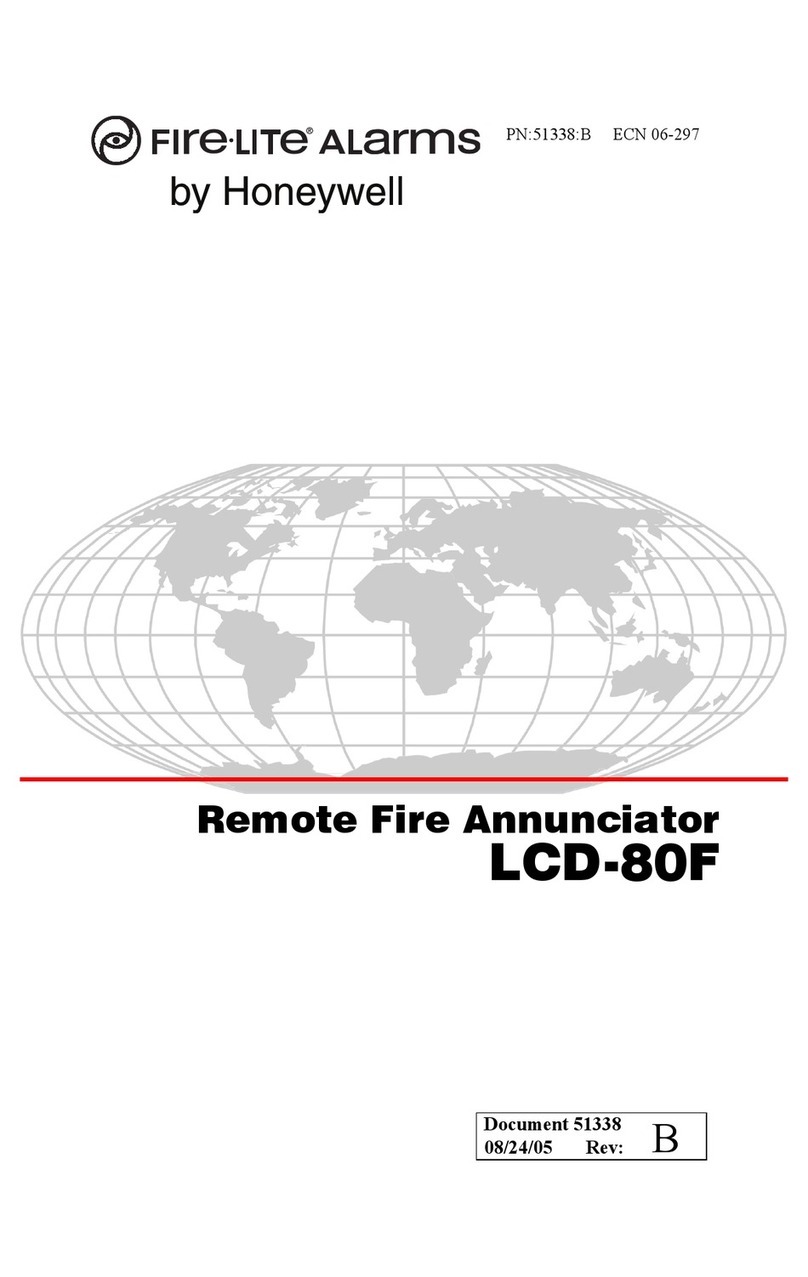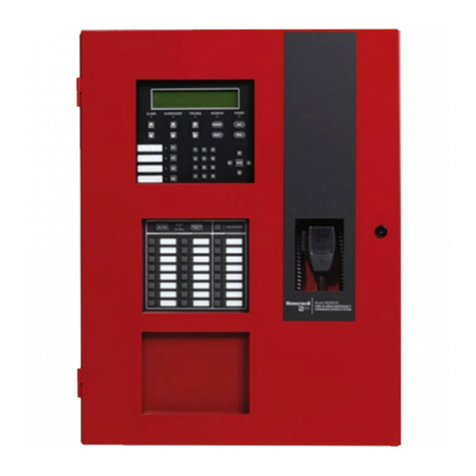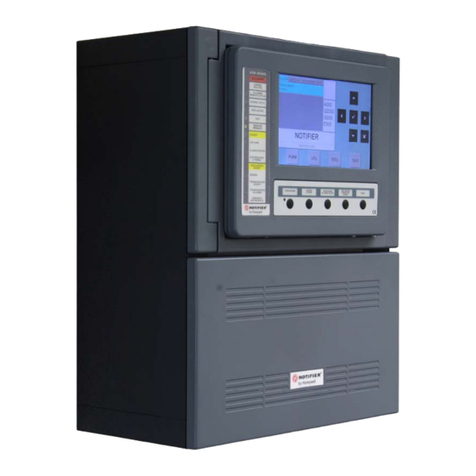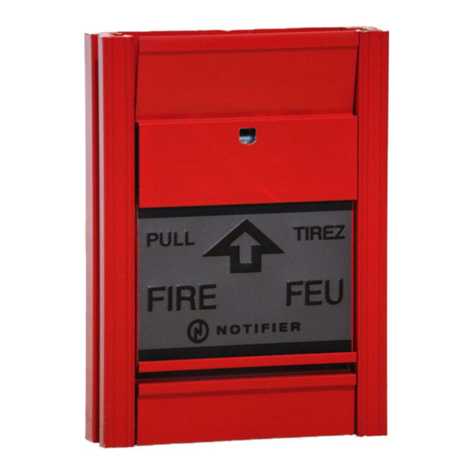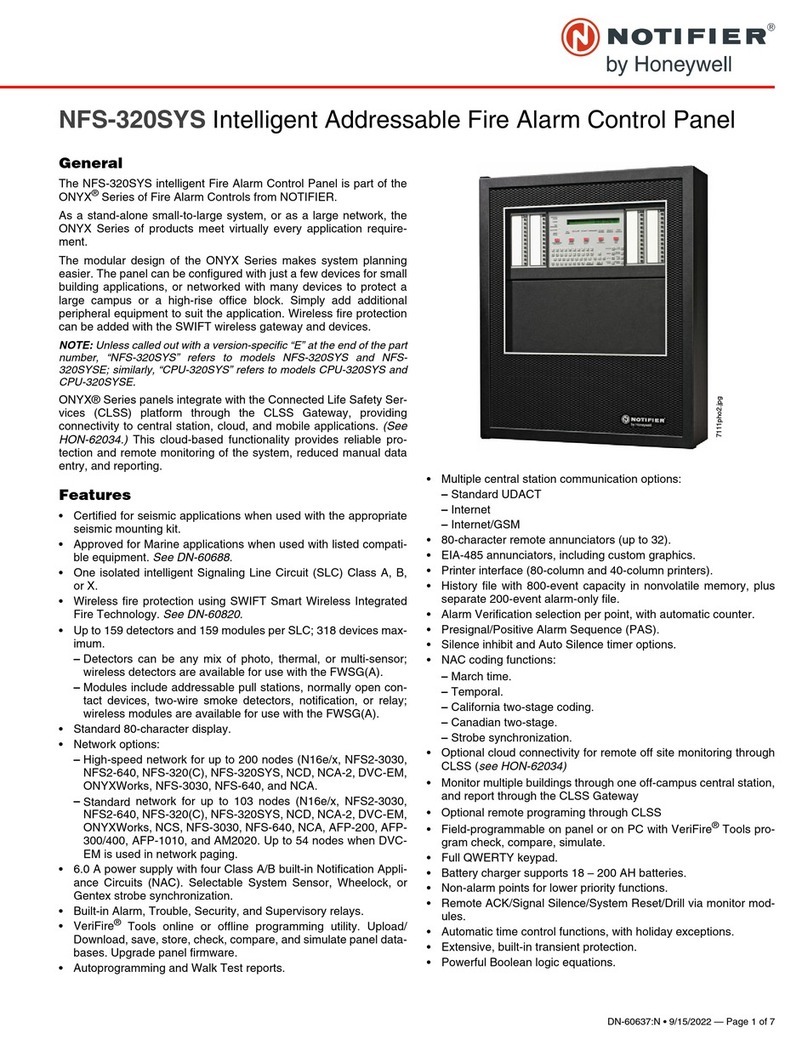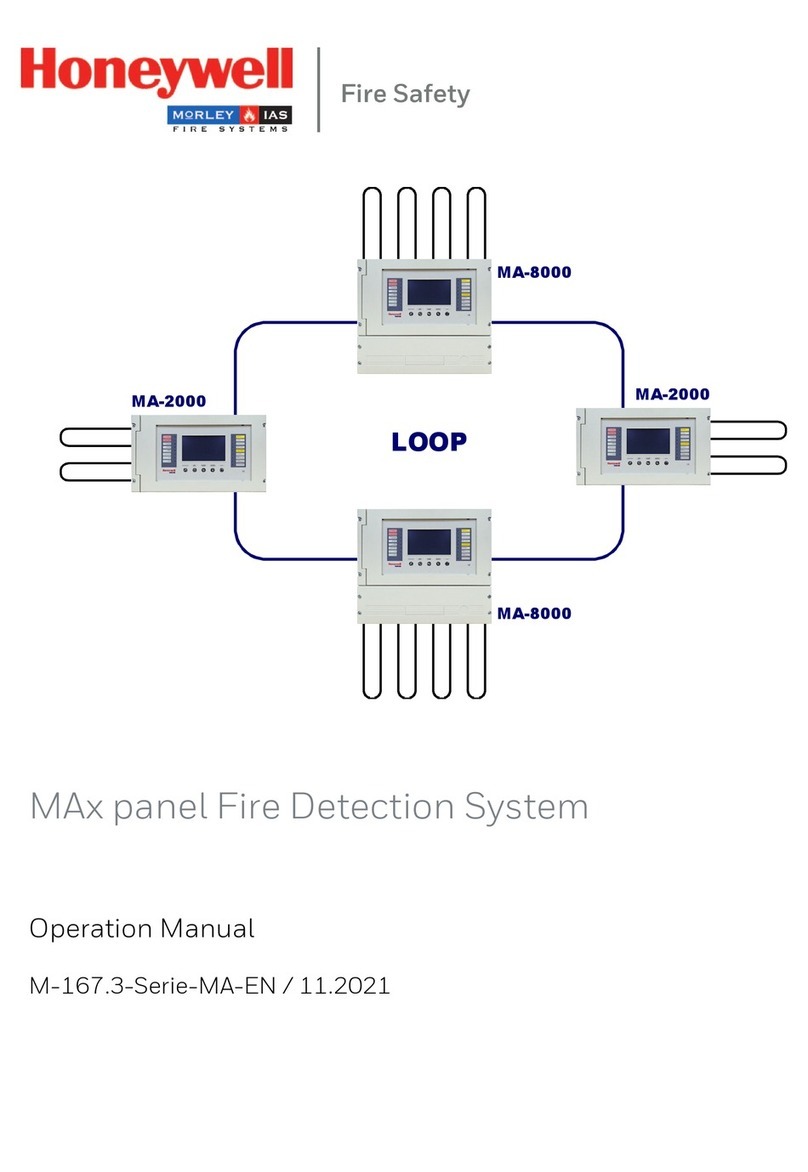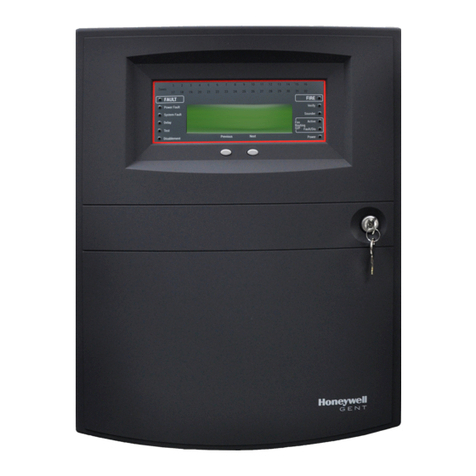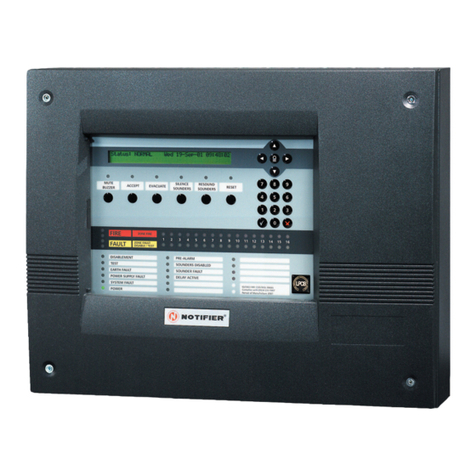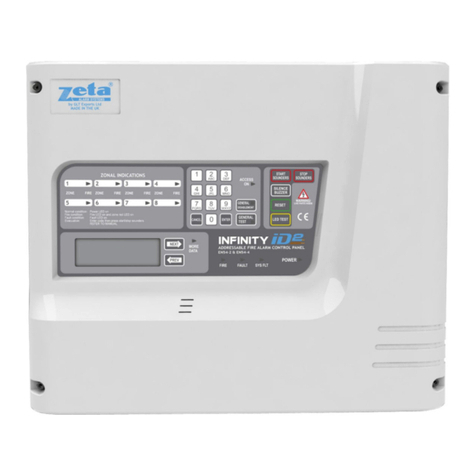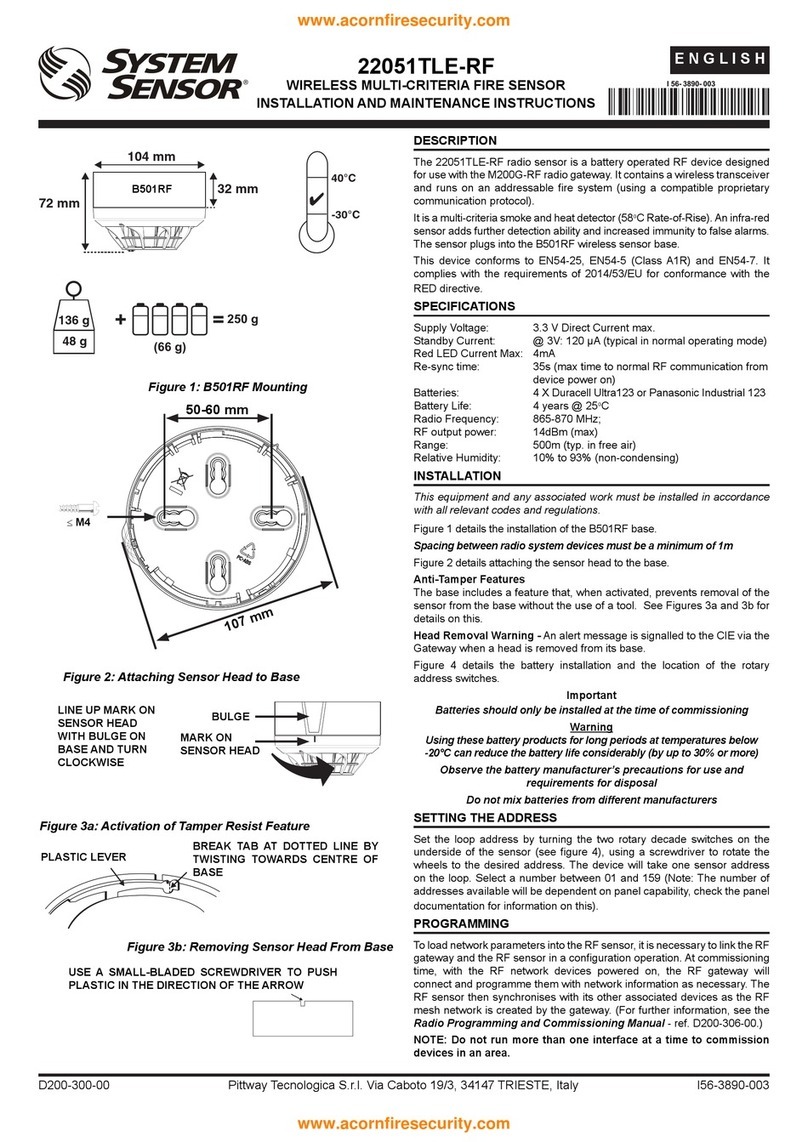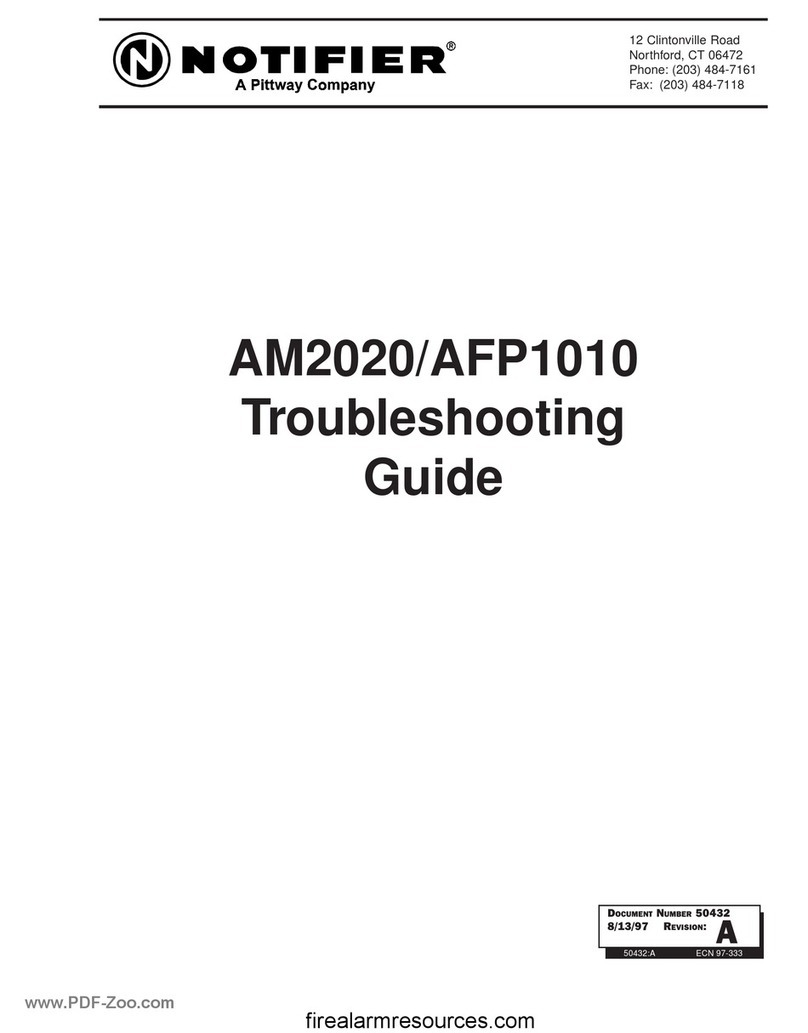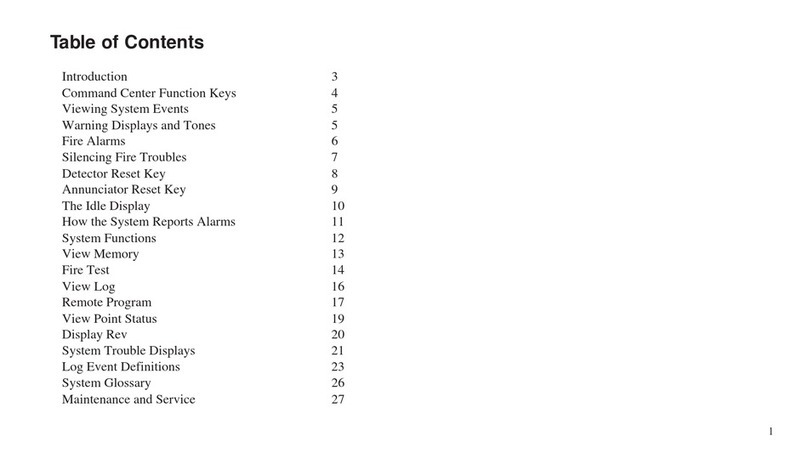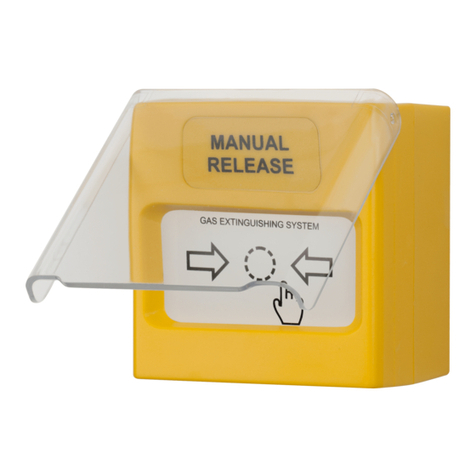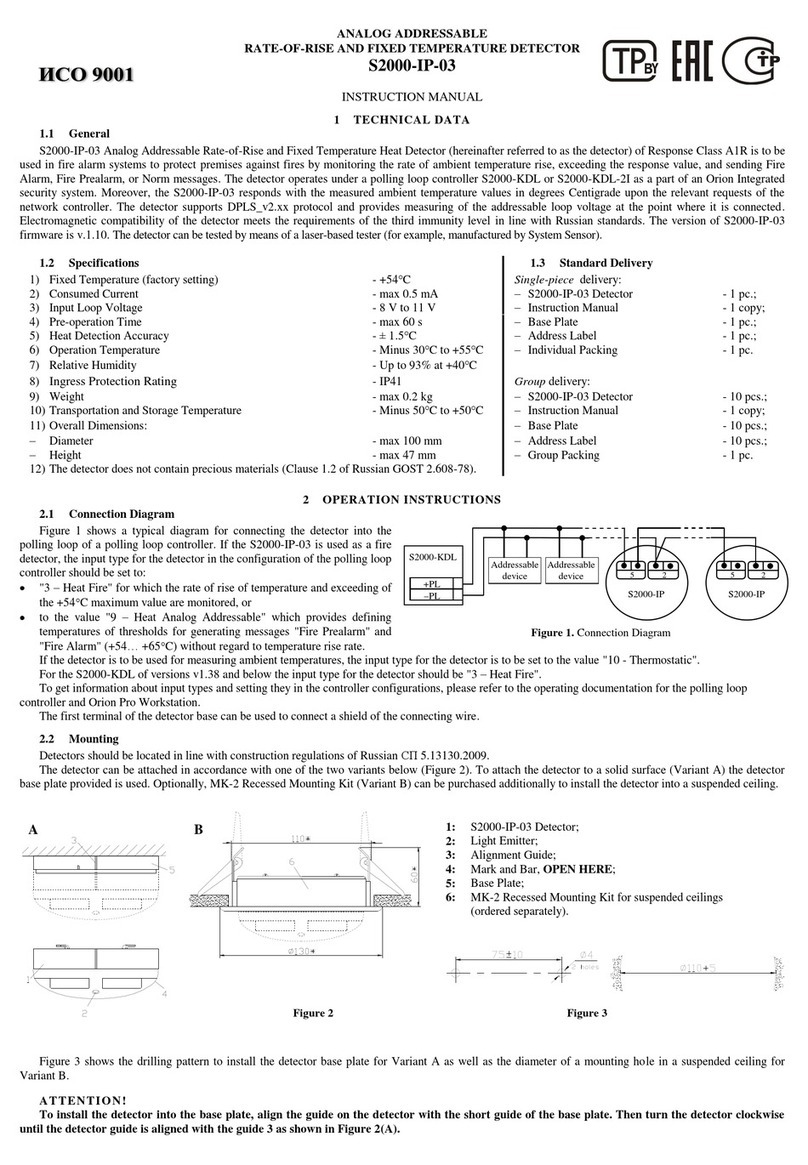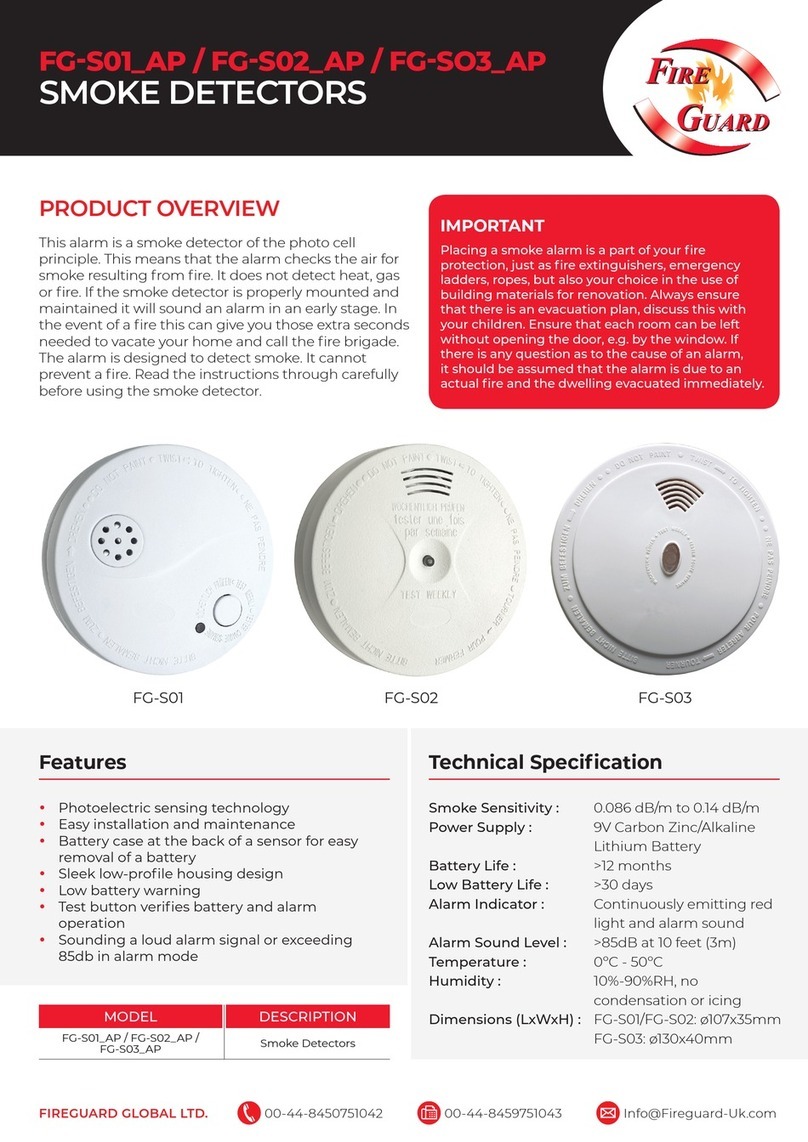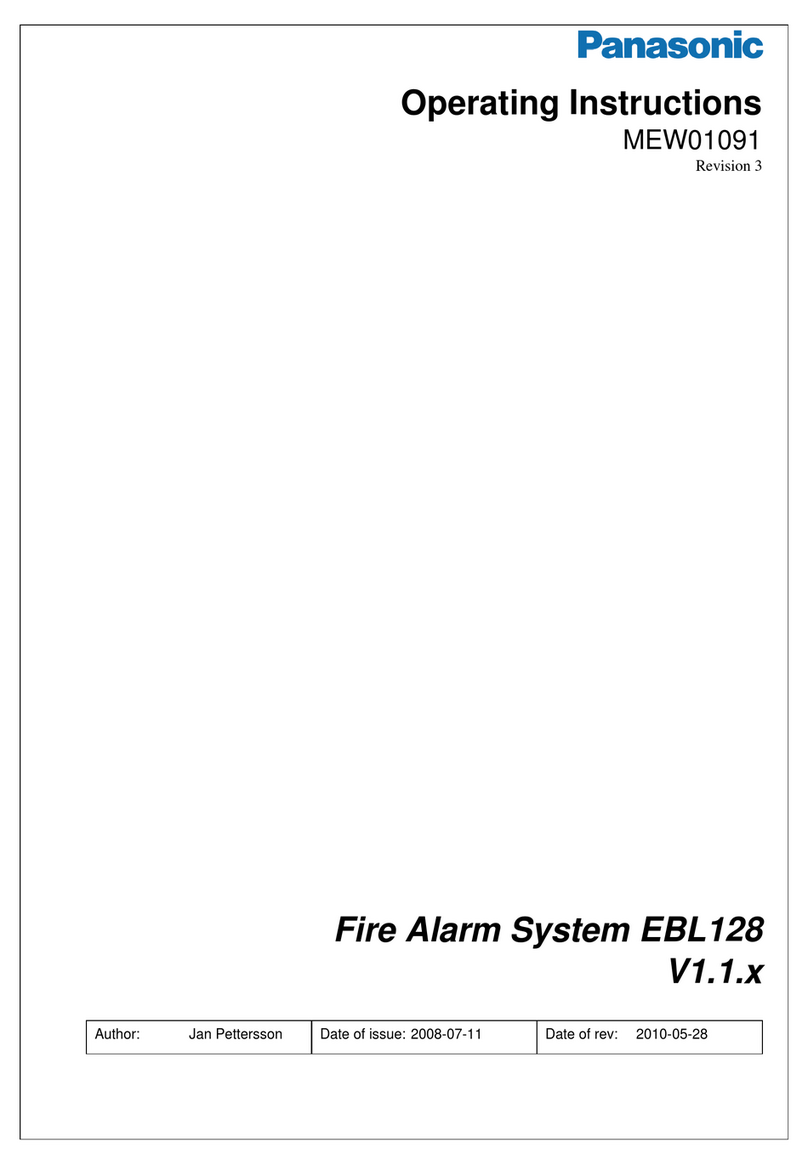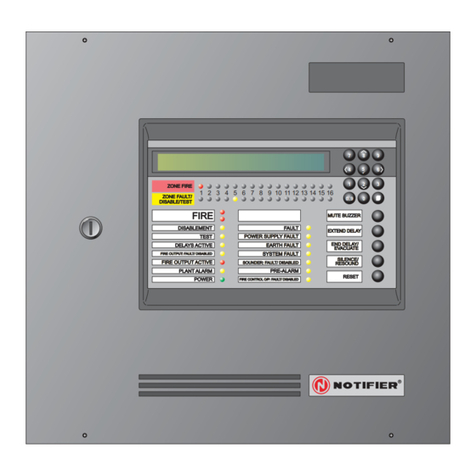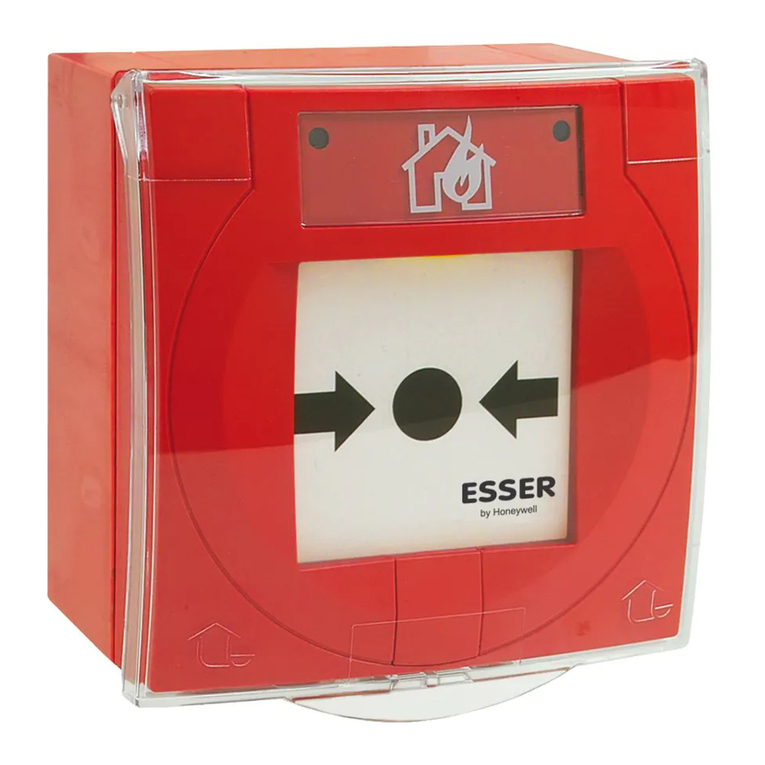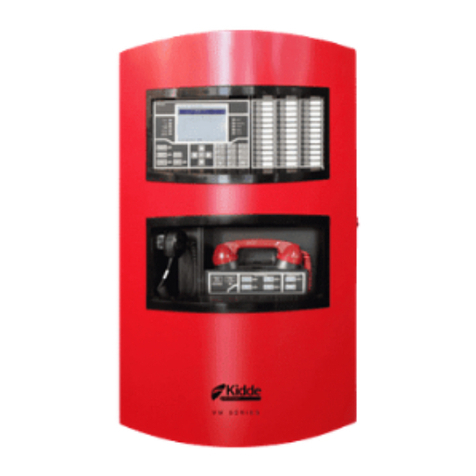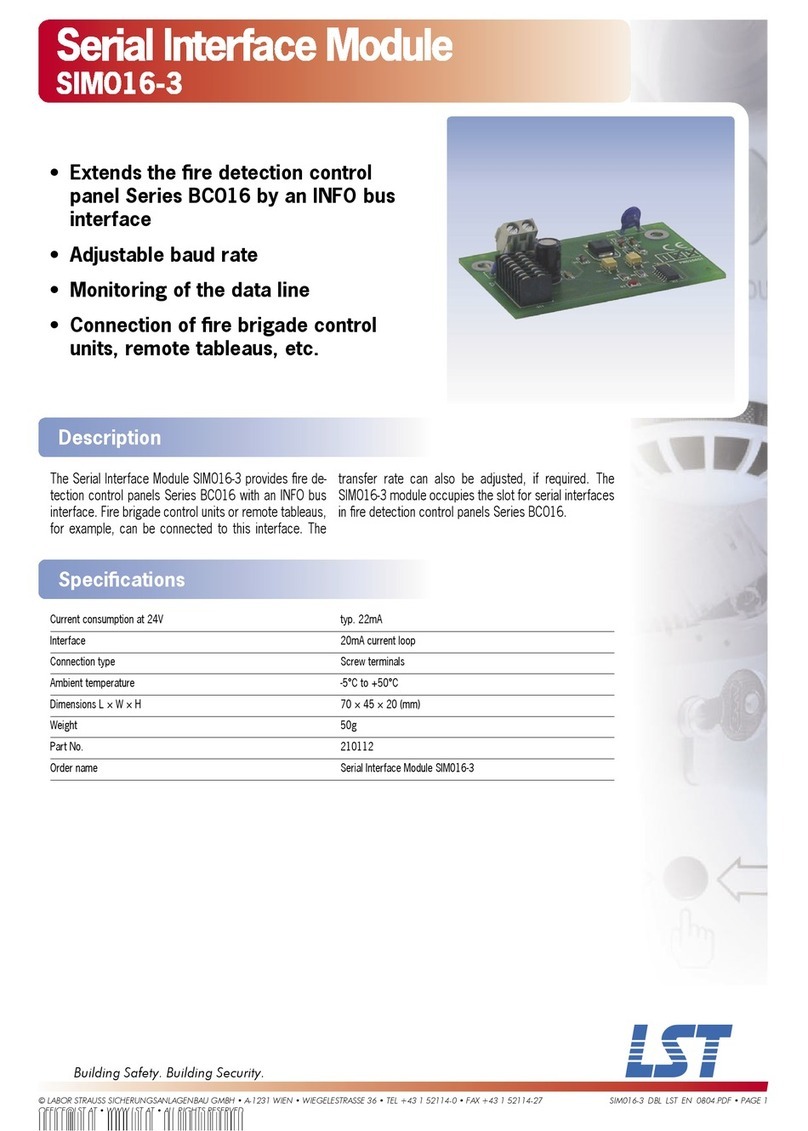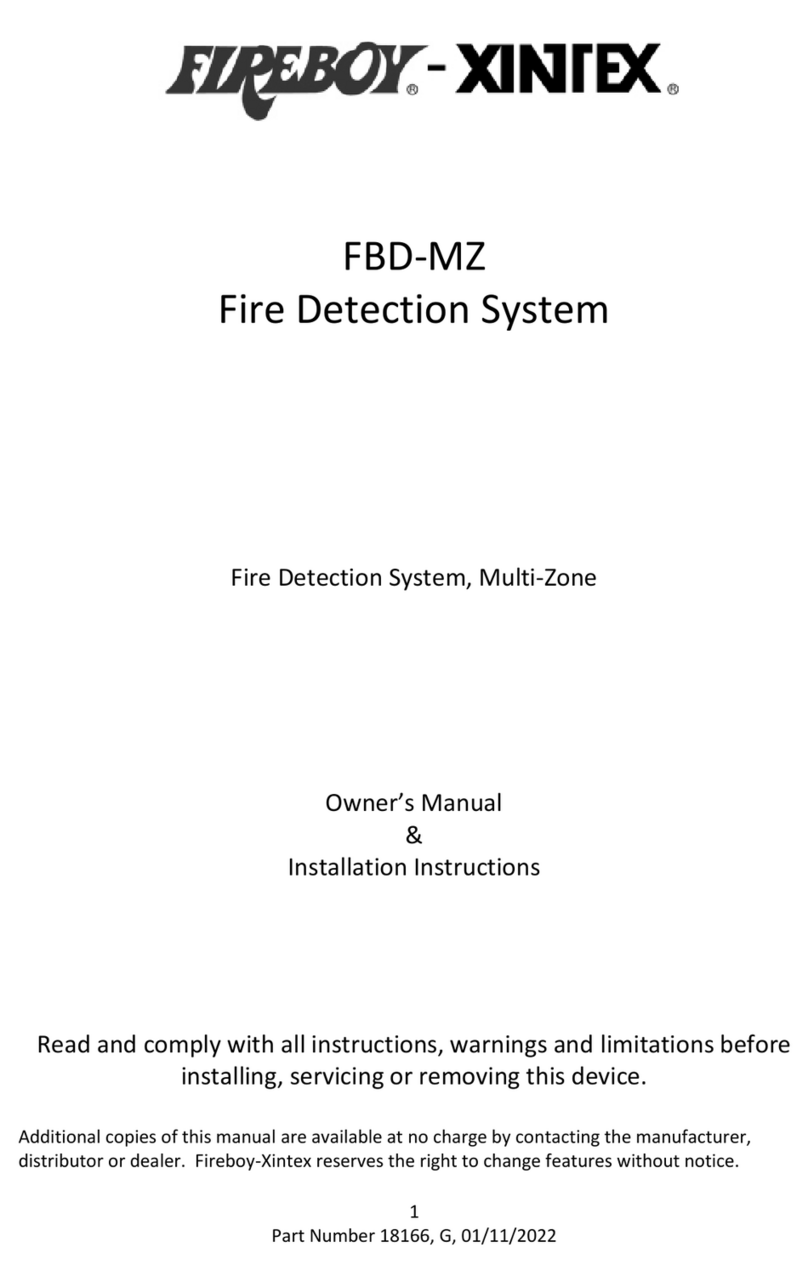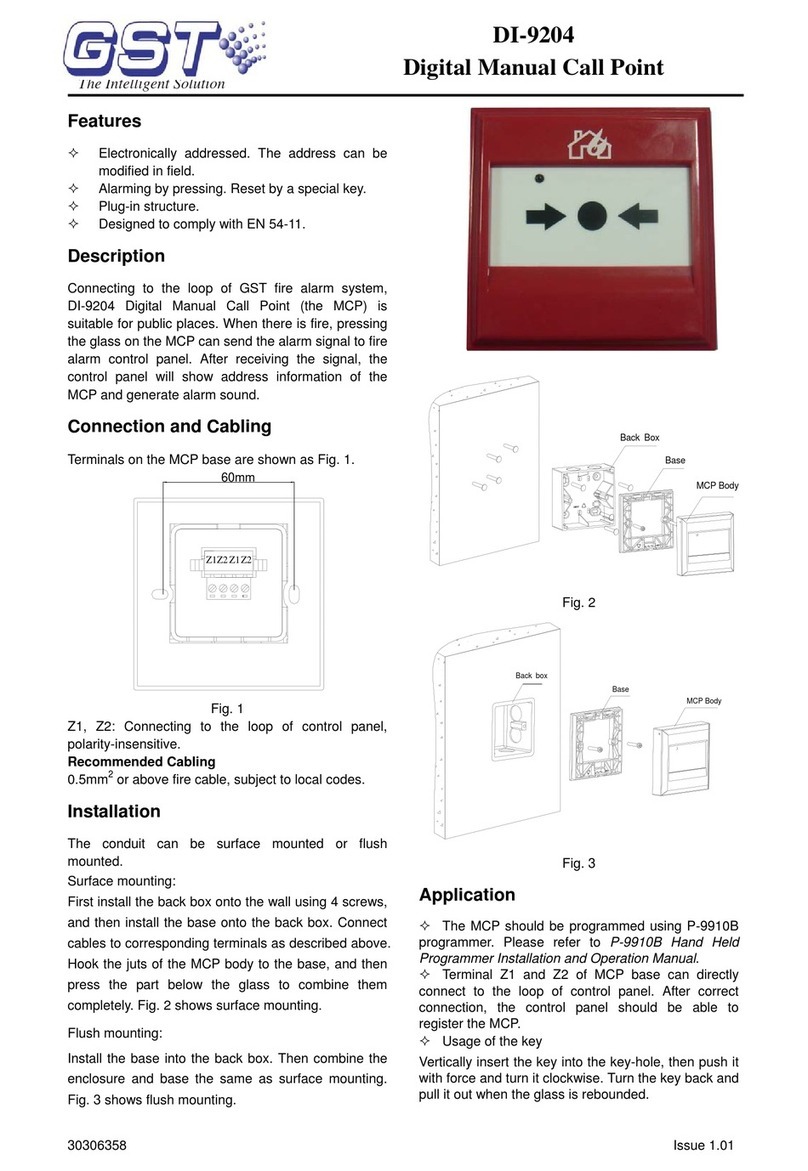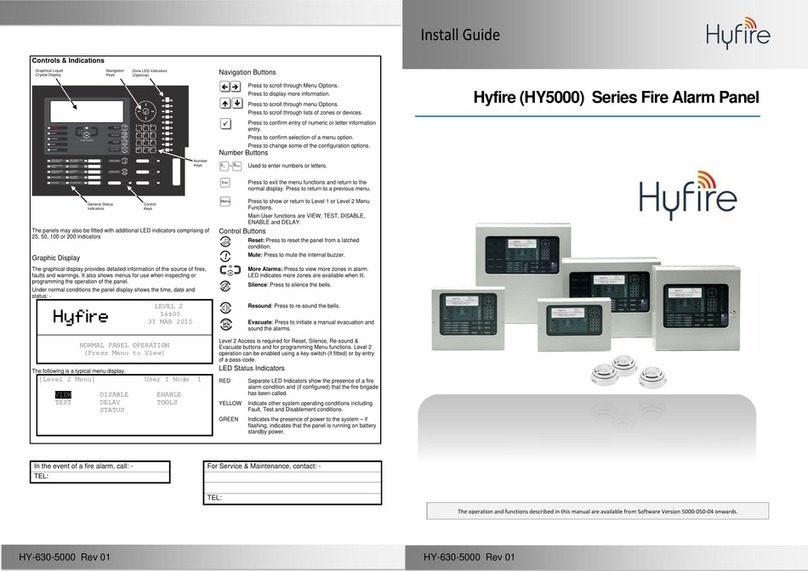
Installationsanleitung
Elektrischer Stopp-Taster für Gaslöschanlagen
Installation Instruction Electrical stop device for
Gas Extinguishing systems
(Art.-Nr. / Part No. 804902)
798933.10 Technische Änderungen vorbehalten!
Technical changes reserved!
03.2011 DGB © 2011 Honeywell International Inc.
Novar GmbH a Honeywell Company
Dieselstraße 2, D-41469 Neuss
Internet: www.esser-systems.de
D
Bei einer Gaslöschanlage, die dem Raumschutz dienen
soll, erfolgt die Flutung-, z.B. mit Kohlendioxid (CO2) erst
nach einer Vorwarnzeit. Hierdurch wird Personen ein
sicheres Verlassen des Flutungsbereiches ermöglicht.
In hohen Konzentrationen kann Kohlendioxid für den
Menschen lebensbedrohlich sein und zum Erstickungs-
tod führen.
Fernmeldekabel I-Y (St) Y n x 2 x 0,8 mm mit besonderer
Kennzeichnung oder Brandmeldekabel verwenden!
Durch den Anschluss der Kabelabschirmung werden die
Signalleitungen gegen Störeinflüsse geschützt.
Bei Servicearbeiten an dem Hand(feuer)melder ist eine evtl.
vorhandene Alarmweiterleitung, wie zum Beispiel die
unbeabsichtigte Auslösung einer Übertragungseinrichtung
(ÜE) zu beachten.
Verwendung des Serviceschlüssels (Art.-Nr. 769916)
ausschließlich durch autorisierte Personen!
Ergänzende und aktuelle Informationen
Die Produktangaben entsprechen dem Stand der
Drucklegung und können durch Produktänderungen,
geänderte Normen / Richtlinien ggf. von den hier
genannten Informationen abweichen.
Aktualisierte Informationen, Konformitätserklärungen und
Instandhaltungsvorgaben siehe www.esser-systems.de.
Dokumentation der Brandmelderzentrale bzgl. Normen,
lokalen Anforderungen und Systemvoraussetzungen
beachten!
GB
When a gas extinguishing system is used to protect rooms,
flooding, e.g. with carbon dioxide (CO2) only takes place
after a set pre-alarm time. This allows people to leave the
area safely.
Carbon dioxide in high concentrations can be harmful
to humans and may cause death by suffocation.
Use clearly identified communications cable
I-Y (St) Y n x 2 x 0.8 mm or fire alarm cable!
Connection of the cable shield to the ground terminal
protects the signal lines against interference.
The alarm activation and triggering of notifying systems e.g.
manned centre link (Master box) must be observed during
any Service of the MCP.
The service key (Part No. 769916) must only be used b
authorized persons!
Additional and updated Informations
The product specification relate to the date of issue and
may differ due to modifications and/or amended
Standards and Regulations from the given informations.
For updated informations, declaration of conformity and
maintenance specifications refer to www.esser-systems.de.
Observe technical manuals of the FACP to ensure
compliance to standards and local requirements of Systems
features!
D
Achtung!
Diese Installationsanleitung ist vor der Inbetriebnahme des Elektrischen
Stopp-Tasters genau durchzulesen. Bei Schäden die durch
Nichtbeachtung der Installationsanleitung verursacht werden, erlischt der
Garantieanspruch. Für Folgeschäden, die daraus resultieren, wird keine
Haftung übernommen.
Sicherheitshinweise
•Der Melder darf NICHT an 230 V AC Netzspannung
angeschlossen und nur im vorgesehenen Temperaturbereich
betrieben werden.
•Die Wartung und Reparatur des Melders darf nur durch eine
Fachkraft erfolgen, die mit den damit verbundenen Gefahren und
Vorschriften vertraut ist.
•Die Veränderung oder ein Umbau des Melders ist nicht zulässig.
Allgemein
Das Elektronikmodul im blauen Gehäuse entspricht der EN 12094-3
und kann somit als elektrischer Stopp-Taster für Gaslöschanlagen in
trockenen, nicht explosionsgefährdeten Betriebsstätten eingesetzt
werden.
Für den Einsatz des Handmelders in einer anderen
Anwendung, wie z.B. als “HAUSALARM“-Taster, sind
werkseitig bedruckte Einleger beigestellt.
Diese Anwendung entspricht jedoch nicht der EN 12094-3.
Bedienung
Die Auslösung der Löschmittelsteuerung kann nur einmal
innerhalb der Vorwarnzeit mit dem Stopp-Taster
unterbrochen werden. Soll die Löschung vollständig
beendet werden, muss der Stopp-Taster gedrückt bleiben
bis an der Löschmittelsteuerung der Alarm zurückgesetzt
wurde.
Unterbrechung
der Auslösung: Glasscheibe eindrücken, Druckknopf drücken und
gedrückt halten, um den Löschvorgang zu
stoppen! - Die rote LED (A) leuchtet.
Mit dem Loslassen wird die noch verbleibende
Vorwarnzeit beendet und die Löschung direkt
ausgeführt.
Ist die Vorwarnzeit bereits abgelaufen, erfolgt die
Flutung direkt mit dem Loslassen des Tasters.
Zum Einstecken des Schlüssels ist die Schlüssellochabdeckung
(B) hochzuschieben (Abb. 3)
Serviceschlüssel (E) nur bei Elektronikmodulen ab Index 05
und gelber Schließung einsetzbar (Abb.2).
Testbetrieb: Vor der Testauslösung ist die Alarmweiterleitung
zu beachten und ggf. abzuschalten!
Serviceschlüssel (E) einstecken und bis zum
Endanschlag in Richtung (Test) drehen.
Rückstellen: Schlüssel (D) oder (E) einstecken, in Richtung
(Test) drehen bis der Druckkopf wieder gelöst
wird.
Montage
Der Handmelder muss auf einer glatten, geeigneten Wandfläche,
z.B. mit Dübeln (S6) und 2-4 Schrauben (Länge ≥40 mm) befestigt
werden.
Öffnen: Schlüssel (D) einstecken und bis zum Lösen der
Verriegelung (C) in Richtung (OPEN) drehen.
Das Gehäuseoberteil leicht nach oben ankippen und
von dem Gehäuseunterteil abnehmen (Abb. 3).
Schließen: Schließung mit dem Schlüssel in Mittelstellung
(Abb. 3) bringen, Oberteil leicht angekippt auf die
oberen Vertiefungen des Unterteiles aufsetzen
und vorsichtig bis zum Einrasten zudrücken.
Beschriftung: In Betrieb
Folie (Abb. 4) in die obere Halterung (F) einlegen
und unter die Führung (G) schieben.
Außer Betrieb
Zur Kennzeichnung eines nicht betriebsbereiten
Melders die Folie umdrehen (Abb. 4).
Transparente Abdeckung (Abb. 5) bei geöffnetem
Meldergehäuse an den Punkten (H) lösen und
entnehmen. Gewünschtes Beschriftungsfeld (J)
von Vorne einlegen. Abdeckung an der
Markierung/Ziffer (K) ausrichten und lagerichtig
wieder aufdrücken.
Glasscheibe: Vor dem Wechsel Glassplitter vorsichtig
entfernen!
Glasscheibe angewinkelt in Position (L) einsetzen
und soweit mit leichtem Druck gegen die
Kunststoffzunge drücken bis die Glasscheibe
unter die beiden Haltewinkel (M) passt (Abb. 6).
Klemmen: Die Schraubklemmen 1-4 können zur
Vereinfachung der Installation abgezogen
werden.
An die Klemme in der linken oberen Ecke des
Gehäuseunterteiles muss die Abschirmung des
Anschlusskabels angeschlossen werden
(Abb. 7/8).
IP 55 Schutz (Option)
Zur Erhöhung der Schutzart von IP 44 auf IP 55 ist für die
Anschlussklemmen der Schutzschlauch (N) (Art.-Nr. 704917) zu
verwenden. Anschlusskabel im Melder zum Schutz vor Feuchtigkeit
mit Abtropfschlaufe verlegen (Abb. 7).
Anschaltung
Der Stopp-Taster muss an die technische Gruppe angeschlossen
werden.
Das Anschlusskabel der Meldergruppe wird an den Klemmenblock
1-4 angeschlossen (Abb. 8).
Technische Daten
Betriebsspannung : 8 V DC bis 30 V DC
Alarmstrom : ca. 9 mA @ 9 V DC
Alarmanzeige : LED, rot
Anschlussklemmen : max. 1,5 mm² (AWG 30-14)
Anwendungstemperatur : -20 °C bis +70 °C
Lagertemperatur : -30 °C bis +75 °C
Schutzart : IP 44 (im Gehäuse)
: IP 55 (mit Option)
Gehäuse : PC ASA-Kunststoff
Gewicht : ca. 236 g (mit Gehäuse)
Maße-Gehäuse (B x H x T) : 133 x 133 x 36 (mm)
Spezifikation : EN 12094-3 : 2003
VdS-Anerkennung : G 205114
CE-Zertifikat : 0786-CPD-20195 / -20494
GB
Important!
This Installation Instruction must be studied carefully before installing
and configuring the electrical stop device. Any damage caused by
failure to observe the installation instructions voids the product
guarantee. Furthermore, no liability can be accepted for any
consequential damage arising from such failure.
Safety information
•NEVER connect the call point directly to a 230 V AC mains power
supply and operate the call point in the specified ambient
temperature range.
•Only qualified technicians who are fully familiar with all the
associated hazards and the applicable legislation and regulations
may perform maintenance and repair work on the call point.
•The call point may not be changed or modified in any way.
General
Electronic module in the blue housing complies with EN 12094-3 and
can thus be used as an electrical stop button for gas extinguishing
systems in dry, non explosive working areas.
Printed labels are included in the delivery in case the
manual control point is to be used for other applications,
such as a “HOUSE ALARM” button.
However, this application does not comply with
EN 12094-3.
Operation
Activation of the extinguishing control equipment can be
interrupted once only with the stop button during the pre-
alarm time. If the extinguishing process is to be completely
terminated, the stop button must be held depressed until
the alarm on the releasing control equipment has been
reset.
Interrupting
activation: Push the glass in, press the button and hold it
depressed to stop the extinguishing process! – The
red LED (A) is lit.
When you release the button, the remaining pre-
alarm time is terminated and the extinguishing
process is executed directly.
If the pre-alarm time has already expired,
extinguishing begins as soon as you release the
button.
Push up the keyhole cover (B) to insert the key (Fig. 3).
Service key (E) only for use with electronic module from
index 05 and yellow colored key lock (Fig. 2).
Test mode: Please observe connected notifying systems before
test activation.
Insert the Service key (E) and turn all the way in the
(Test) direction.
Reset: Insert the key (D) or (E) and turn it in direction
(Test) until the pressed button is released.
Installation
Install the call point securely on a suitable wall with a smooth
surface, e.g. with 2-4 screws (length ≥40 mm) and dowels (S6).
Opening the
unit: Insert the key (D) and turn in the (OPEN)
direction to release the cover lock (C). Lift up the
bottom edge of the cover a little to release it and
then remove the cover (Fig. 3).
Closing the
unit: With the key in the centre position to release the
lock (Fig. 3) position the upper edge of the cover
in the groove at the top of the base and then
press the cover down until it locks into position.
Identification: In Operation
Position the plastic label (Fig. 4) on the retaining
pins (F) and push it under the guides (G).
Out-of-Order
The other side of the label can be used for identifying
call points that are not in operation (Fig. 4).
With the call point housing open remove the
transparent plastic label cover (Fig. 5) by prising it
out at points (H). Then insert the appropriate
identification label (J) from the front. Align the
cover with the mark/number (K) and snap it back
into place, checking that it is aligned correctly.
Glass screen: Remove any broken splinters before replacing the
glass!
Push the top edge of the replacement screen up
against lug (L) and then press the screen gently
into position so that it snaps under the two
retaining lugs (M) at the bottom of the window
(Fig. 6).
Terminals: The screw terminals 1-4 can be removed if
desired to make the installation procedure easier.
Connect the shield of the connection cable to the
ground terminal in the upper left corner of the
housing base (Fig. 7/8).
Protection rating IP 55 (option)
To achieve a higher IP-rating from IP 44 to IP 55 cover the terminals
with the appropriate protective cap (N) (Part No. 704917). Install
inlaying cable with a dripping bend to protect the device from
dampness (Fig. 7).
Wiring
The stop device must be connected to the technical alarm zone.
Connect the detector zone connection cable to terminals 1-4 (Fig. 8).
Specifications
Power supply : 8 V DC to 30 V DC
Alarm current : approx. 9 mA @ 9 V DC
Alarm indicator : LED, red
Connection terminals : max. 1.5mm² (AWG 30-14)
Application temperature : -20 °C to +70 °C
Storage temperature : -30 °C to +75 °C
Protection rating : IP 44 (in housing)
: IP 55 (with option)
Housing : PC ASA plastic
Weight : approx. 236 g (with housing)
Housing dimensions (w x h x d) : 133 x 133 x 36 (mm)
Specification : EN 12094-3 : 2003
VdS approval : G 205114
CE certificate : 0786-CPD-20195 / -20494
